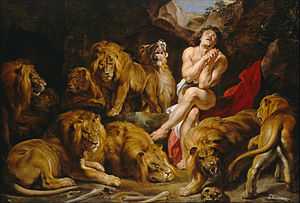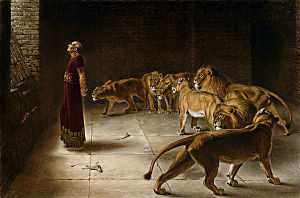Daniel in the lions' den
Daniel's age


The story of Daniel in the lions' den is found in the sixth chapter of the Book of Daniel in the Hebrew Bible, and in the lesser known story of Bel and the Dragon in the Greek versions. Daniel is an official in the Persian empire under King Darius. Darius (at the instigation of his other officials) had made a decree that no one was to offer prayer to any god or man except him for a period of thirty days. Daniel continued to pray as was his habit, knowing that praying would have him killed. For this action, Darius had him arrested and thrown into a lions' den. However, he was unharmed, and after he was released the following morning, the people who had cajoled the king into making the decree (for the sole purpose of getting at Daniel) were thrown into the lions' den themselves.
Dating the narrative

Critical scholars speculate the dating of the authorship of chapter 6. Paul L. Redditt postulates, "the only issues here are when people in the Diaspora began to tell the story and when its hero became Daniel."[3] Louis F. Hartman and Alexander Di Lella place the story more broadly within the Persian period, basing it on Persian loanwords.[4]
Literary structure
Based on Wayne S. Towner's work,[5] John E. Goldingay outlined the contents of Daniel 6 with the chiastic structure presented below.[6] This is supported by Ernest C. Lucas,[7] but critiqued by Tremper Longman and David E. Garland.[8]
- A. Introduction: Daniel’s success (vv.1-3)
- B. Darius’s edict and Daniel’s response (vv.4-10)
- C. Daniel’s opponents plot his death (vv.11-15)
- D. Darius hopes for Daniel’s deliverance (vv.16-18)
- D'. Darius witnesses Daniel’s deliverance (vv.19-23)
- C'. Daniel’s opponents sentenced to death (v.24)
- C. Daniel’s opponents plot his death (vv.11-15)
- B'. Darius’s edict and doxology (v.25-27)
- B. Darius’s edict and Daniel’s response (vv.4-10)
- A'. Conclusion: Daniel’s success (v.28)
Chapter 6
| Chapters of the Book of Daniel | ||||||||||||||||||||||||||||
|---|---|---|---|---|---|---|---|---|---|---|---|---|---|---|---|---|---|---|---|---|---|---|---|---|---|---|---|---|
 | ||||||||||||||||||||||||||||
|
||||||||||||||||||||||||||||
According to the Book of Daniel, Darius the Mede took over the kingdom of Babylon when he was sixty-two years of age.[5:31] This introduces the sixth chapter where Daniel is appointed to serve as one of three royal administrators over the satraps who governed throughout the kingdom.[v.1-2]
Daniel was a distinguished government official who possessed exceptional qualities that won the favor of Darius, who planned to appoint him over the whole kingdom. As a result, the other administrators in the same service as well as the satraps themselves investigated Daniel for any behavior they could use against him. They found nothing, so they conspired against Daniel by urging the king to issue this decree: that anyone in the next thirty days, found praying to god or man, other than the king, shall be fed to the lions.[v.3-8]
Darius put the decree in writing in accordance with the laws of the Medes and Persians, which could not be altered or abolished, not even by Darius himself (according to the text). The conspirators used this as leverage to convict Daniel of treason, knowing he prayed to his God, Yahweh, three times a day. As soon as they caught Daniel, they informed the king about what they discovered. As per the law, and despite Darius' attempts to find a way around it, ultimately Darius was forced to have Daniel thrown into the lions’ den[v.9-16] and a stone was placed over the mouth of the entrance. The king sealed it with his own signet ring and with the rings of his nobles.[v.17]
Darius spent the night fasting, unable to sleep.[v.18] The next morning, Darius called to Daniel to find out if God had rescued him.[v.19-20] Daniel replied that God sent an angel to shut the mouths of the lions so as not to hurt him, because he was blameless before his God and his king.[v.22] He was then brought out of the den unscathed.[v.23]
Daniel’s accusers and their families, however, were thrown into the lions’ den and did not even reach the bottom of the pit before being consumed by the lions.[v.24] Darius then wrote a letter to all the peoples, nations, and tongues, magnifying the God of Daniel, Yahweh.[v.25-28] Daniel thus prospered in the reign of Darius and in the reign of Cyrus the Persian.[v.28] [9]
Daniel’s regular prayer
It was customary for Daniel to pray to God, Yahweh, three times a day in his upper chambers, while facing Jerusalem with his windows open. He prostrated himself in prayer, giving thanks to God. Despite hearing the news of the royal decree, Daniel continued to do what he always had—go home and pray. His actions were not meant to provoke the authorities.[10]
Daniel in the lions' den
Throughout the Ancient Near East, and even in the Hebrew Bible, lions have often been symbolic of monarchs. The lions surrounding Daniel could be seen as a symbolic representation of the nations and empires of the world.[11]
Daniel released
Daniel was released from the lions' den and his accusers and their families were thrown in to meet the fate they had intended for him. The Greek Septuagint version specifies that the accusers were the other two administrators and their families, not necessarily the entire lot of 120 satraps.[12]
Parallels with chapter 3
The story of Daniel in the lions' den in chapter 6 is similar to the story of Shadrach, Meshach, and Abednego in Daniel 3. David Syme Russell notes a number of parallels between the two chapters, including the trials suffered, the jealousy of conspirators, rescue by an angel, accusers meeting the same fate they had intended for the protagonists, and the fact that the king praises God and issues a royal decree protecting Jewish worship.[13]
Rabbinic literature

According to Josippon, "the beasts in the den received Daniel as faithful dogs might receive their returning master, wagging their tails and licking him." The Midrash Tehillim says that "the mouth of the den was closed with a huge stone, which had rolled of itself from Palestine to Babylon for that purpose" and that "upon this stone sat an angel in the shape of a lion, so that Daniel's enemies might not harass him."[14]
Christian analysis
James B. Jordan suggests that the motive of the satraps was to hurt Darius, who would lose a useful man should Daniel perish, so Daniel suffers on behalf of Darius, and does, in fact, rescue him. In applying the traditional Christian interpretation of the Hebrew Bible as a series of prefigurations of the gospel story, Jordan also writes that "the fact that the den was sealed points forward to the seal on Jesus' tomb."[15]
Depiction in art
Although Daniel is sometimes depicted as a young man in illustrations of the incident, James Montgomery Boice points out that he would have been over eighty years old at the time.[2]
Artists who have depicted this incident include:
- Jan Brueghel the Younger, Daniel in the lions' den
- Briton Rivière, Daniel's Answer to the King
- Peter Paul Rubens, Daniel in the Lions' Den
- David Teniers the Younger, Daniel in the lions' den
- Bastille (band), "Daniel in the Den"
See also
| Wikimedia Commons has media related to Daniel in the lions' den. |
Footnotes
- ↑ National Gallery of Art.
- ↑ 2.0 2.1 Boice 2006, p. 68.
- ↑ Redditt 1999, p. 102
- ↑ Lella 1983, p. 179
- ↑ Towner 1984, p. 79
- ↑ Goldingay 1989, p. 124
- ↑ Lucas 2002, p. 164
- ↑ Longman & Garland 2009, p. 115
- ↑ Shepherd 2009, pp. 86-88.
- ↑ Shepherd 2009, p. 87.
- ↑ Hays & Longman 2010, p. 242.
- ↑ Shepherd 2009, p. 88.
- ↑ Russell 1981, p. 98.
- ↑ Jewish Encyclopedia.
- ↑ Jordan 2007, p. 322.
References
- Redditt, Paul L. (1999). Daniel: based on the New Revised Standard Version. Sheffield: Sheffield Academic Press. ISBN 978-1-84127-009-8.
- Lella, a new translation with notes and commentary on chapters 1-9 by Louis F. Hartman. Introd., and commentary on chapters 10-12 by Alexander Di Lella (1983). The Book of Daniel (1. ed. 3. print. ed.). New York [u.a.]: Doubleday. p. 197. ISBN 978-0-385-01322-2.
- Goldingay, John E. (1989). Daniel. Dallas, Tex.: Word Books. ISBN 978-0-8499-0229-1.
- Towner, W. Sibley (1984). Daniel. Atlanta: Westminster John Knox Press. ISBN 978-0-8042-3122-0.
- Lucas, Ernest (2002). Daniel. Leicester, England: Apollos. ISBN 978-0-8308-2519-6.
- Longman & Garland, editors, Tremper Longman III & David E. Garland (2009). Daniel-Malachi (Rev. ed. ed.). Grand Rapids, Mich.: Zondervan. ISBN 978-0-310-26893-2.
- Boice, James Montgomery (2006). Daniel: An Expositional Commentary. Baker Books.
- "Daniel in the Lions' Den". Washington, DC: National Gallery of Art. Retrieved 15 September 2011.
- Hays, J. Daniel; Longman, Tremper, eds. (2010). Message of the prophets : a survey of the prophetic and apocalyptic books of the Old Testament. [Grand Rapids, Mich.]: Zondervan. ISBN 978-0-310-27152-9.
- "Jewish Encyclopedia" [Daniel].
- Jordan, James B. (2007). The Handwriting on the Wall: A Commentary on the Book of Daniel. American Vision.
- Russell, D. S. (1981). 1. Bible. O. T. Daniel - Commentaries. Philadelphia: Westminster Press. ISBN 978-0-664-24567-2.
- Shepherd, Michael B. (2009). Daniel in the context of the Hebrew Bible. Studies in Biblical Literature 123. Peter Lang. ISBN 978-1-4331-0539-5.